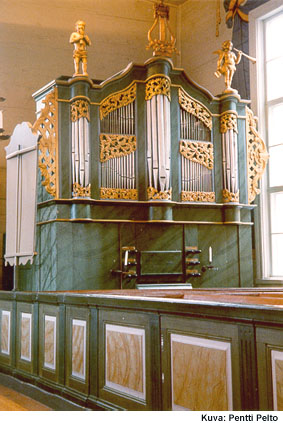|
HISTORICAL ORGANS IN FINLAND 
Uusikaarlepyy.Church- Telin, Anders 1768
- 8 stops, 1 manual and pedal
- mechanical action and mechanical stop action
The Uusikaarlepyy organ was built by Anders Telin of Kokkola, a competent master shipwright who had studied in Sweden and who built a great many ships in his native town. Possibly hard times in the shipbuilding industry forced him to turn to organ building in the 1760s, although he had shown an interest in that field earlier too.
Anders Telin appears to have begun work on this particular organ with no commission. The Parish of Uusikaarlepyy decided to buy the completed instrument, and it was installed in the loft above the main entrance of Uusikaarlepyy Church, built by Elias Brenner in 1708. The organ was inaugurated on May 26, 1768 and remained in use until 1909, when a new organ was acquired. Seminary lecturer Iivari Forsman-Koskimies moved the Telin organ to the north transept of the church, which is where it remains to this day. Koskimies kept the organ in working order and even gave recitals on it; the instrument was still more or less workable at the turn of the 1960s. Today, the organ is no longer playable, but it remains a significant monument in the history of Finnish organs.
Anders Telin may have used components from an older organ when building this one: the chests and perhaps some wood pipes. This has not been conclusively proven, however. The structure and compass of the chests clearly date them to the 17th century, and the organization and structure of the pallets shows that the pedal coupler once functioned through a second row of pallets, although Telin did not use this in his construction.
Façade
The five-part façade of the Uusikaarlepyy organ consists of three towers and the two-tiered flats between them. The semi-circular mouldings topping the towers curve upwards. The towers are light and graceful, containing only five pipes each. The flats between the towers, by contrast, contain a notably high number of pipes — 15 each. The visual weight of the massive wood structures in relation to the façade pipes is greater than is usual for the era. The façade is typical of the Swedish-Finnish 18th-century tradition, although the builder’s hallmark is clearly visible in many of the details.
The organ case as seen from the church floor contains the manual division, keyboards and action. The top of the manual division has upward-opening hatches that can be propped open with bars housed inside the organ case. Behind the manual division is a second cabinet containing the pipes of the two pedal stops. The cabinets are linked by a low substructure containing the bellows, wind trunks and pedal action. Juhani Martikainen has observed that this substructure, which is fitted with a railing, bears a resemblance to the deck of a ship. The organ is painted blue-green, and some of the decorations are gold-coloured.
Technical features
The chest framework is a massive sheet consisting of pine boards glued beside each other. It is quite long but rather shallow for structural reasons. The grooves are sawed and chiselled into the frame sheet. The lower half of the grooves is closed at the rear with a pallet and at the front with a block that resembles a second pallet but is fixed. The sliders and the thin, single-tier upper board are conventional in structure.
The console is in the middle of the lower part of the façade. The action leads up to the manual chest and back to the pedal chest. The wedge-shaped bellows, feeding directly into the chests, are still functional. Their structure and mechanism, beginning with the pumping pedals side by side in the rear wall, are unusual.
The manual keyboard has a veneer of what is evidently some type of Finnish hardwood. The keys have subsequently been painted. The action is practical but contains some unconventional structures. The stop knobs have ample movement.
Musical properties
The compass of the instrument is C/E-c3. The manual and pedal have had a short octave, which was later tuned chromatically. The pedal was furnished with two extra notes at some point (C sharp and E flat); thus, its original compass included a short octave: C, D, E-a0.
At present, it is impossible to gain an impression of what the organ sounds like. Examination of the pipes reveals that the sound was basically typical for its era, although the pipes are roughly fashioned with no finesse, and the builder does not seem to have been particularly sensitive in his voicing, either. The volume of the organ must have seemed insufficient for the church, since the manual division has hinged top hatches that can be propped open using bars hanging from them.
The disposition is curious in that the pedal is an independent division, a rarity in an 18th-century organ of this size.
Original disposition
Manual C/E-c3 | Pedal C,D,E-a0 |
|
Gedacht 8’ | Subbas 8’ | |
Principal 4’ | Bassun 16’ | |
Spetsfleut 4’ | Fixed pedal coupler | |
Qvinta 3’ | | |
Octava 2’ | | |
Trompet B/D 8’ | | |
| | |
| | |
| | |
| | |
| | |
| | |
| | |
|
|
|
The Trompet was subsequently replaced with a more modern violin stop. | | |
| | |
| | |
| | |
| | |
| | |
| | |
| | |
| | |
| | |
| | |
| | |
| | |
Further information
Martikainen, Juhani: Orglar i Finland från tiden 1600-1800. Dissertation, Sibelius Academy 1997.
Hannikainen, Päivi-Liisa: Suomen urut Hülphers-käsikirjoituskokoelmassa, in Hannikainen (ed.): Soikaa urut, laulakaa klaveerit. Sibelius Academy 1998.
Österbacka, Svante: Kort historik för orgelveckan i Pedersörenejden 1979. Photocopy.
|